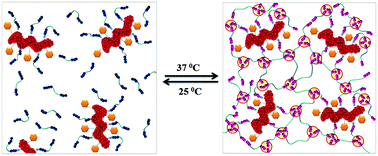Heparin-based temperature-sensitive injectable hydrogels for protein delivery†
Abstract
Stimuli-sensitive injectable hydrogels, composed of biodegradable copolymers, have emerged as prominent candidate materials for the sustained delivery of therapeutic drugs. In this study, we developed a biodegradable and temperature-sensitive injectable hydrogel system based on heparin-bearing poly(ε-caprolactone-co-lactide)-b-poly(ethylene glycol)-b-poly(ε-caprolactone-co-lactide) (Hep–PCLA) as the carrier system for lysozyme. Hep–PCLA conjugates are capable of undergoing temperature-induced sol-to-gel transitions in an aqueous solution. The gelation rate, mechanical strength, and viscosity of Hep–PCLA conjugates are controllably tunable by varying the graft density of PCLA copolymers to heparin. The gel window in which Hep–PCLA forms a gel covers the physiological conditions (37 °C), i.e., free flowing Hep–PCLA in aqueous solutions (25 °C) could form a hydrogel at body temperature. Using an in vitro cytotoxicity test, Hep–PCLA conjugates were found to be non-toxic to fibroblast cells, even at high concentrations. Lysozyme, chosen as a model protein, was effectively loaded into Hep–PCLA conjugates using ionic and hydrophobic interactions. The lysozyme-loaded conjugates readily formed a hydrogel when implanted in the back of Sprague-Dawley rats, and retarded the initial burst of lysozyme release, exhibiting sustained release. Our results show that biodegradable, temperature-sensitive injectable Hep–PCLA hydrogels can be used as sustained protein carriers.

- This article is part of the themed collection: 2015 Journal of Materials Chemistry B Hot Papers

 Please wait while we load your content...
Please wait while we load your content...